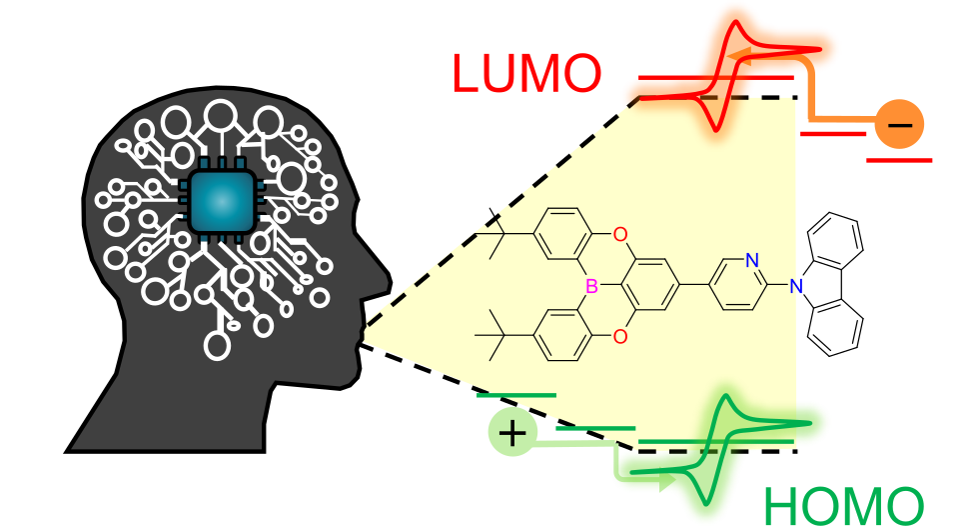Deep learning for development of organic optoelectronic devices: Efficient prescreening of hosts and emitters in deep-blue fluorescent OLEDS
| author | Dong Hoon Choi and Sungnam Park |
|---|---|
| Homepage | https://ultrafastspec.wixsite.com/spark |
| journal | npj computational materials |
The highest occupied molecular orbital (HOMO) and lowest unoccupied molecular orbital (LUMO) energies, which are key factors in optoelectronic devices, must be accurately estimated for newly designed materials. Here, we developed a deep learning (DL) model that was trained with an experimental database containing the HOMO and LUMO energies of 3,026 organic molecules in solvents or solids and was capable of predicting the HOMO and LUMO energies of molecules with the mean absolute errors of 0.058 eV. Additionally, we demonstrated that our DL model was efficiently used to virtually screen optimal host and emitter molecules for organic light-emitting diodes (OLEDs). Deep-blue fluorescent OLEDs, which were fabricated with emitter and host molecules selected via DL prediction, exhibited narrow emission (bandwidth = 36 nm) at 412 nm and an external quantum efficiency of 6.58%. Our DL-assisted virtual screening method can be further applied to the development of component materials in optoelectronics.
« Prev An Activity-Based Fluorescent Probe for Imaging Fluctuations ...
 An Activity-Based Fluorescent Probe for Imaging Fluctuations ...
2023.05.08by webmaster2
〈
An Activity-Based Fluorescent Probe for Imaging Fluctuations ...
2023.05.08by webmaster2
〈
Photocatalytic Superoxide Radical Generator that Induces Pyto... Next »
 Photocatalytic Superoxide Radical Generator that Induces Pyto...
2023.05.08by webmaster2
〉
Photocatalytic Superoxide Radical Generator that Induces Pyto...
2023.05.08by webmaster2
〉
Articles
- Self-Aggregating Tau Fragments Recapitulate Pathologic Phenotypes and Neurotoxici...
-
 Ultranarrow Mid-infrared Quantum Plasmon Resonance of Self-Doped Silver Selenide ...
Ultranarrow Mid-infrared Quantum Plasmon Resonance of Self-Doped Silver Selenide ...
-
 Molecular Thermoelectricity in EGaIn-Based Molecular Junctions
Molecular Thermoelectricity in EGaIn-Based Molecular Junctions
-
 Perovskite Nanocatalsts Protected by Hermetically Sealing for Highly Bright and S...
Perovskite Nanocatalsts Protected by Hermetically Sealing for Highly Bright and S...
-
 The importance of a charge transfer descriptor for screening potential CO2 reduct...
The importance of a charge transfer descriptor for screening potential CO2 reduct...
-
 Resonant Raman-Active Polymer Dot Barcodes for Multiplex Cell Mapping
Resonant Raman-Active Polymer Dot Barcodes for Multiplex Cell Mapping
-
 Decoding the Roles of Amyloid-β (1-42)'s Key Oligomerization Domains toward Desig...
Decoding the Roles of Amyloid-β (1-42)'s Key Oligomerization Domains toward Desig...
-
 Flattening bent Janus nanodiscs expands lattice parameters
Flattening bent Janus nanodiscs expands lattice parameters
-
 Directing the surface atomic geometry on copper sulfide for enhanced electrochemi...
Directing the surface atomic geometry on copper sulfide for enhanced electrochemi...
-
 High Seebeck Coefficient Achieved by Multinuclear Organometallic Molecular Junctions
High Seebeck Coefficient Achieved by Multinuclear Organometallic Molecular Junctions
-
 Thermopower in Transition from Tunneling to Hopping
Thermopower in Transition from Tunneling to Hopping
-
 An Activity-Based Fluorescent Probe for Imaging Fluctuations of Peroxynitrite (ON...
An Activity-Based Fluorescent Probe for Imaging Fluctuations of Peroxynitrite (ON...
-
 Deep learning for development of organic optoelectronic devices: Efficient prescr...
Deep learning for development of organic optoelectronic devices: Efficient prescr...
-
 Photocatalytic Superoxide Radical Generator that Induces Pytoptosis in Cancer Cells
Photocatalytic Superoxide Radical Generator that Induces Pytoptosis in Cancer Cells
-
 Direct C-H metallation of tetrahydrofuran and application in flow
Direct C-H metallation of tetrahydrofuran and application in flow
-
 Functionalization of Diamine-Appended MOF-Based Adsorbents by Ring Opening of Epo...
Functionalization of Diamine-Appended MOF-Based Adsorbents by Ring Opening of Epo...
-
 High Gravimetric and Volumetric Ammonia Capacities in Robust Metal-Organic Framew...
High Gravimetric and Volumetric Ammonia Capacities in Robust Metal-Organic Framew...
-
 Li-ion Intercalation, Rectification, and Solid Electrolyte Interphase in Molecula...
Li-ion Intercalation, Rectification, and Solid Electrolyte Interphase in Molecula...
-
 Thermopower of Molecular Junction in Harsh Thermal Environments
Thermopower of Molecular Junction in Harsh Thermal Environments
-
 Microfluidics-Assisted Synthesis of Hierarchical Cu2O Nanocrystal as C2-Selective...
Microfluidics-Assisted Synthesis of Hierarchical Cu2O Nanocrystal as C2-Selective...
Designed by sketchbooks.co.kr / sketchbook5 board skin
